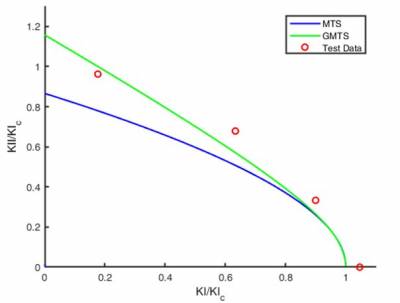Table of Contents
MJF: Fracture resistance
This page is the entry point of the future section dedicated to description of fatigue resistance of MJF materials. In the initial version, it contains the results of studies of fracture resistance of High Reusability Polyamide 12in the A_MADAM project.
Fracture resistance of High Reusability Polyamide 12
The research of fracture resistance of High-reusability polyamide 12 (HR PA12) is in its initial phase, and only the initial results are known. They are obtained experimentally, using the Inclined Edge Cracked Semi-Circular Bend (IACSB) specimen subjected to three-point bend loading. All the tested specimens were manufactured so that AM layers were in the plane of the specimen.
In order to obtain the various combinations of modes, only the parameters S2/R and α were varied in the testing campaign of A_MADAM project, while S2 was kept fixed at 42 mm, and the values of t, R and a were the same for all the specimens (t=6mm, R=60 mm, a=24 mm), except for three samples that had manually made notch. The various combinations of S2/R and α were used to achieve the fracture modes Mode I, Mode II and mixed modes I-II. When the bottom supports are located symmetrically to the crack line (i.e., when S1 = S2) and the crack line is in the same direction as the load (i.e., when α = 0°), the specimen is subjected to Mode I (opening mode). To obtain mixed mode I-II or Mode II (sliding mode), an appropriate combination of S1/R and α should be chosen.
Fracture toughness of HR PA12 is assessed by comparison of the results of the experiments with the results of experiments of glass-filled polyamide PA12 GF3200 specimens that were produced using SLS technology. The following table shows comparison of the of some measures of fracture toughness of two materials during the experiments with the specimens with identical shapes, notches and loading conditions. The first line of the table presents the result of the specimens with manually created notch. For explanation of the variables please see the explanation of the experimental method,
| Configuration | Mean stiffness (N/mm) | Mean Peak Force (N) | ||||||
|---|---|---|---|---|---|---|---|---|
| α (deg) | S1 (mm) | S2 (mm) | HR | GF3200 | ratio | HR PA12 | GF3200 PA12 | ratio |
| 0 | 42 | 42 | 1150* | 2050* | 0.56* | 2820* | 3350* | 0.84* |
| 1190 | 2190 | 0.54 | 3220 | 3830 | 0.84 | |||
*results of the specimens with manually created notch
The obtained results clearly indicate that the polyamide HR PA12 (manufactured by MJF technology) has lower consistently lower fracture toughness than glass-filled polyamide GF3200 PA12 (manufactured by SLS technology).
Fracture criterium
By analogy with the glass filled polyamide PA12 the obtained results may be interpreted within the framework of criteria based on maximum tangential stress, which are used for determining fracture toughness of brittle materials. The Maximum Tangential Stress (MTS) criterium has worse results than Generalized Maximum Tangential Stress (GMTS) criterion, as evidenced by the following figure. The blue line is obtained by fitting the data to MTS model, and green line is obtained by fitting the data to GMTS model. Red circles represent results obtained using specimens with notches built during MJF production process.

